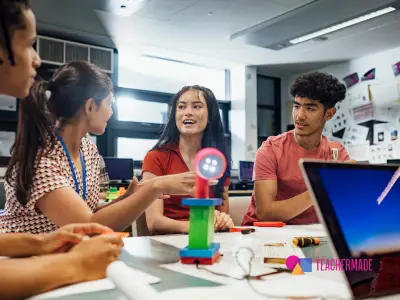Are you looking for the Classworks Special Education program from TouchMath? Click here to go to their site.
Are you looking for the Classworks Special Education program from TouchMath? Click here to go to their site.
Is your classroom routine a little tired? Routine helps your students feel safe by keeping expectations predictable. The problem is that teachers can get locked into a handful of teaching strategies.
That can hurt your student’s learning in the long run. Students need access to a variety of ways to learn each day. Sometimes they need to see a concept in many different ways before it can stick.
You may have tried doing learning style inventories with your students so that students can see what learning styles work best. But are you actually employing different learning modes inside of your classroom? Or maybe you’d like to mix it up, but it feels like you may have to reinvent your entire classroom routine.
The good news is you can add multimodal learning in small ways throughout your week. We’ve rounded up some simple ideas to get you to think about using multimodal learning in your classroom today.

Multimodal learning uses multiple sensory modalities or channels (such as visual, auditory, kinesthetic, and tactile) to enhance the learning experience and promote a deeper understanding of concepts. Instead of relying on a single mode of communication, such as traditional lectures or text-based materials, multimodal learning engages learners through various senses and media.
In multimodal learning, information is presented in different formats, such as text, images, videos, audio, and interactive elements, to cater to different learning preferences and maximize the learning potential of students. By incorporating multiple modes of representation, it allows learners to access and process information using their preferred sensory channels, reinforcing their understanding and retention of the material.
Multimodal learning recognizes that individuals have diverse learning styles and preferences. Some students may learn better through visual cues, while others may benefit from auditory explanations or hands-on activities. By presenting information through multiple modalities, educators can reach a broader range of students and create a more inclusive learning environment.
Multimodal learning also acknowledges the power of multimedia in engaging students and making learning more interactive and dynamic. It leverages technology and digital tools to integrate different modes of representation seamlessly, enabling students to explore, interact, and construct knowledge in a more personalized and meaningful way.
These examples demonstrate how teachers can incorporate different forms of media and technology to create a multimodal learning environment that caters to diverse learning styles and engages students in a variety of ways.
TeacherMade makes it easy to infuse multimodal learning into your everyday classroom activity. With TeacherMade you can:
TeacherMade makes it easy to transform what you already have and add the most successful multimodal strategies. When multimodal teaching is easy, you can incorporate it into everyday teaching. See TeacherMade in action: